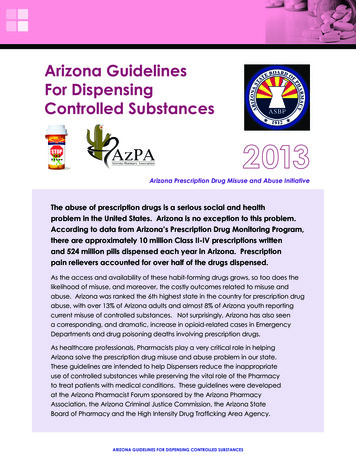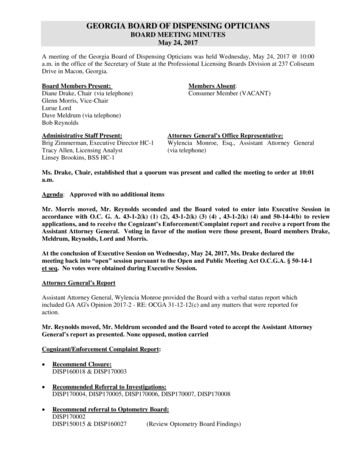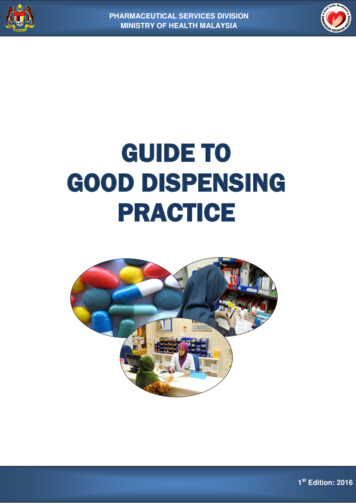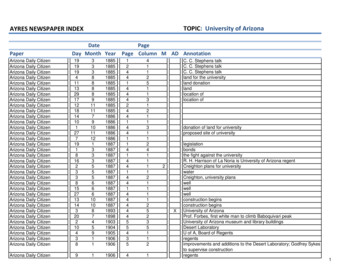
Transcription
Arizona GuidelinesFor DispensingControlled SubstancesArizona Prescription Drug Misuse and Abuse InitiativeThe abuse of prescription drugs is a serious social and healthproblem in the United States. Arizona is no exception to this problem.According to data from Arizona’s Prescription Drug Monitoring Program,there are approximately 10 million Class II-IV prescriptions writtenand 524 million pills dispensed each year in Arizona. Prescriptionpain relievers accounted for over half of the drugs dispensed.As the access and availability of these habit-forming drugs grows, so too does thelikelihood of misuse, and moreover, the costly outcomes related to misuse andabuse. Arizona was ranked the 6th highest state in the country for prescription drugabuse, with over 13% of Arizona adults and almost 8% of Arizona youth reportingcurrent misuse of controlled substances. Not surprisingly, Arizona has also seena corresponding, and dramatic, increase in opioid-related cases in EmergencyDepartments and drug poisoning deaths involving prescription drugs.As healthcare professionals, Pharmacists play a very critical role in helpingArizona solve the prescription drug misuse and abuse problem in our state.These guidelines are intended to help Dispensers reduce the inappropriateuse of controlled substances while preserving the vital role of the Pharmacyto treat patients with medical conditions. These guidelines were developedat the Arizona Pharmacist Forum sponsored by the Arizona PharmacyAssociation, the Arizona Criminal Justice Commission, the Arizona StateBoard of Pharmacy and the High Intensity Drug Trafficking Area Agency.ArIzonA GUIDelIneS For DISPenSInG ConTrolleD SUbSTAnCeS
The work group was composed of members representing: /RFDO 5HWDLO 3KDUPDFLHVCorporate PharmaciesMidwestern UniversityUniversity of Arizona&RXQW\ DQG 6WDWH HDOWK 2IÀ FLDOVInsurance CompaniesThe National Meth and Pharmaceutical Initiative/RFDO 6XEVWDQFH EXVH &RPPXQLW\ &RDOLWLRQV V GHÀ QHG E\ WKH ,QVWLWXWH RI 0HGLFLQH JXLGHOLQHV DUH V\VWHPDWLFDOO\ GHYHORSHG statements to assist practitioner and patient decisions about appropriate health careIRU VSHFLÀ F FOLQLFDO FLUFXPVWDQFHV µ V VXFK WKHVH JXLGHOLQHV DUH LQWHQGHG WR SURYLGH general advice to the Pharmacist working in retail Pharmacies throughout Arizona.The Arizona Guidelines for Dispensing Controlled Substances should never be reliedon as a substitute for proper assessment and professional judgment for the particularcircumstances of each case.Thank you for reviewing these Guidelines and doing your part to protect the health,safety and welfare of Arizona’s citizens.RECOMMENDATIONSArizona Guidelines for Dispensing Controlled Substances1: Pharmacists should check the Arizona Prescription Drug Monitoring3URJUDP EHIRUH GLVSHQVLQJ FRQWUROOHG VXEVWDQFHV DQG VSHFLÀ FDOO\ LQ the following circumstances: 5HJXODU SDWLHQWV DW OHDVW RQFH SHU \HDU Any prescription for Oxycodone 15mg or 30mg All Schedule II or Schedule III drugs for:o Every new or unknown patiento All weekend and late day prescriptionso Prescriptions written far from the location of thePharmacy or the patient’s residenceo Any time suspicious behavior is noted (e.g., nervous,overly talkative, agitated, emotionally volatile, evasive,etc for more information see Appendix A) Use clinical judgment in these situations:o Any prescription written for a controlled substancein high doses or high quantitieso Any prescription considered an outlier to what isnormally prescribed (use clinical judgment) Additional recommendations:o It is recommended that pharmacists document a note2ARIZONA GUIDELINES FOR DISPENSING CONTROLLED SUBSTANCES
LQ WKHLU SDWLHQW·V ÀOH LQFOXGLQJ GDWH LQLWLDOV DQG DFWLRQ taken to indicate that the PDMP was checkedo It is recommended that all pharmacists in the pharmacy, includingSDUW WLPH ÁRDWHUVµ UHFHLYH HGXFDWLRQ RQ XVH RI WKH 3'03The following is the direct link to PDMP information:http://www.azpharmacy.gov/CS-Rx Monitoring/practioner procedures.aspFor additional information on the PDMP please contact the Arizona StateBoard of Pharmacy at (602) 771-2744 or dwright@azpharmacy.gov2: Pharmacists should use clinical judgment on the appropriatenessof communicating with Prescribers prior to dispensing a controlledVXEVWDQFH EXW VKRXOG VSHFLÀFDOO\ GR VR LQ WKH IROORZLQJ FLUFXPVWDQFHV Pharmacist suspects a forged, altered or counterfeit prescription 3DWLHQW LV UHSHDWHGO\ UHTXHVWLQJ HDUO\ UHÀOOV RI FRQWUROOHG VXEVWDQFHV 3DWLHQW LV VSHFLÀFDOO\ UHTXHVWLQJ HDUO\ UHÀOOV RI Opioids, Benzodiazepines or Carisoprodol Patient presents with a high quantity from the Emergency Department Any time suspicious behavior is noted (e.g., nervous, overly talkative, agitated,emotionally volatile, evasive, etc .for more information, see Appendix A) It is recommended that pharmacists establish face-to-face contact with the(PHUJHQF\ 'HSDUWPHQW 'LUHFWRU LI WKH\ UHFHLYH KLJK WUDIÀF IURP (' SDWLHQWV It is recommended that pharmacists call the phone number forthe prescriber listed in their computer vs. the phone number on theprescription to avoid false numbers on forged prescriptions3: Pharmacists should use clinical judgment on the appropriatenessof communicating with other pharmacies prior to dispensingD FRQWUROOHG VXEVWDQFH EXW VKRXOG VSHFLÀFDOO\ FRQWDFW other Pharmacies in the following circumstances: If you receive a prescription that has been denied by another pharmacist If you deny a patient a prescription, it is recommended that youcall/fax all pharmacies within a 5 mile radius to alert them It is important to note that cross-communication between pharmaciesregarding a patient’s health and treatment is NOT a violation of HIPPA4: 3KDUPDFLVWV VKRXOG UHTXLUH D JRYHUQPHQW LVVXHG LGHQWLÀFDWLRQ IRU DOO new or unknown patients before dispensing any controlled substance. If you suspect a fake ID is involved, conduct the followingYHULÀFDWLRQ VWHSV VHH SSHQGL[ % IRU PRUH GHWDLOV Squeeze the ID to make sure the weight and rigidity matches AZ IDs /RRN IRU VTXDUHG HGJHV PRVW ,'V KDYH URXQGHG HGJHV 8 VLQJ WKH SDGV RI \RXU ÀQJHUV OLJKWO\ IHHO IRU EXPSV ULGJHV ARIZONA GUIDELINES FOR DISPENSING CONTROLLED SUBSTANCES3
and irregularities on the front and back surfaces of the ID Check for font or coloration differences (e.g., different font style,improper bolding, lack of shading, spelling errors, or the wrong font size) Check the front and back for words like secure, valid,genuine or credibility status (these are common false VHFXULW\ PHDVXUHVµ SODFHG RQ IDNH ,'V 5 HTXHVW DQRWKHU IRUP RI ,' H J D FUHGLW FDUG DV SHRSOH ZKR present fake IDs are often reluctant to produce another form ,I \RX FRQÀUP D IDNH ,' GR QRW GLVSHQVH WKH SUHVFULSWLRQ5: 3KDUPDFLVWV VKRXOG QRW ÀOO D SUHVFULSWLRQ LI WKH\ EHOLHYH LW LV IRUJHG altered, or counterfeited & DOO WKH SUHVFULEHU WR YHULI\ ÀUVW XVH WKH SKRQH QXPEHU IRU the provider in your computer vs. on the prescription Be familiar with the types of fraudulent prescriptions and characteristicsof forged prescriptions (see Appendix C for details) Fill out a DEA FaxNet form for all fraudulent .pdf. If a pharmacist denies a prescription, it is recommended that thepharmacist notify other local pharmacists (in a 5 mile radius); again crosscommunication between pharmacists is NOT a violation of HIPPA If you believe you have discovered a pattern of prescription abuse,FRQWDFW \RXU 6WDWH %RDUG RI 3KDUPDF\ \RXU ORFDO '( RIÀFH \RXU ORFDO VKHULII·V RIÀFH RU SROLFH GHSDUWPHQW UHSRUWLQJ FDQ EH DQRQ\PRXV Be familiar with the law and your legal and ethical responsibilities;according to the DEA (see appendix A and C for details): It is unlawful to knowingly dispense controlled substances forDQ\WKLQJ RWKHU WKDQ D OHJLWLPDWH PHGLFDO SXUSRVHµ There is no legal obligation to dispense a prescription, especiallyone of doubtful, questionable, or suspicious origin To do so with a chemically dependent patient may violatefederal or state provisions on maintenance of addiction, and youcould be liable if the patient later injures himself or others Under these circumstances, it is safer to politely refuse to dispense theprescription and to refer the patient to his/her attending physician for furtherPDQDJHPHQW 'RFXPHQW DQ\ VXFK HQFRXQWHUV LQ WKHLU SDWLHQW ÀOHV If possible, retain the prescription; however, even a fraudulent prescription isregarded as private property and should be returned promptly to the individual There is no legal requirement to contact the police regarding asuspected drug seeker; however, because a minority of drug seekers,particularly those who are chemically dependent, may resort toverbal abuse or acts of violence, it is advisable that you do so4ARIZONA GUIDELINES FOR DISPENSING CONTROLLED SUBSTANCES
6: Pharmacists should educate their patients about properstorage and proper disposal during the patient consultationprior to dispensing controlled substances. This is especially true if there are youth in the home, given thatprescription drugs are now the 4th most used substance by teens andPRVW UHSRUW REWDLQLQJ WKHP LQ WKH KRPH UL]RQD RXWK 6XUYH\ Storage tips should include never leaving any controlledVXEVWDQFH RXW LQ WKH RSHQµ LQ VLWXDWLRQV OLNH NLWFKHQ FRXQWHUV unlocked medicine cabinets, or even purses or handbags 'LVSRVDO WLSV VKRXOG LQFOXGH QHYHU ÁXVKLQJ SUHVFULSWLRQV down the toilet or throwing them in the trash Disposal tips should also include information on takeback events and permanent drop box locations If take-back events or drop boxes are unavailable, instruct yourpatients to use the DEA disposal guidelines and FDA tips: Take the drugs out of their original containers and mix them with anundesirable substance, such as used coffee grounds or kitty litter; thenput them in a sealable bag, empty can, or other container to preventthe medication from leaking or breaking out of a garbage bag Before throwing out a medicine container, tell the patient toscratch out all identifying information on the prescription labelto protect their identity and personal health information Tell your patients to not share medication with friends, family or others andremind them that doing so could pose a serious health risk to someone It is encouraged that you use the information sheetsavailable in Appendix D and E as handouts for patients; formore information, please see www.DrugFreeAz.org/Rx; andhttp://www.deadiversion.usdoj.gov/drug disposal/index.htmlLIST OF APPENDIXESA. Identifying the Drug Seeking Patient in a Pharmacy% ,GHQWLI\LQJ )DNH ,GHQWLÀFDWLRQC. Pharmacist’s Guide to Prescription FraudD. Patient Education: Teen Abuse of Prescription & OverThe-Counter Medicine Now an EpidemicE. Patient Education: How to Dispose of Unused MedicinesAppendix A: Identifying The Drug Seeking Patient In A Pharmacy&KHPLFDOO\ GHSHQGHQW SDWLHQWV RIWHQ FRPH WR SKDUPDFLHV IRU HDUO\ UHÀOOV of their prescriptions. These patients may appear to be experiencingARIZONA GUIDELINES FOR DISPENSING CONTROLLED SUBSTANCES5
acute withdrawal symptoms and may become extremely agitated, tearfuland violent if they cannot obtain their drug of choice, or a substitute.Alternatively, patients who present with a lethargic, disinterested, perhapsgiddy or overly friendly personality style, slurred speech and staggeringgait may be intoxicated and seeking more drugs. An overly familiarpresentation, intruding on an appropriate professional interpersonalspace, or even covert or overt seductiveness should arouse suspicions.A patient cannot be readily diagnosed as chemically dependentin a pharmacy setting. However, chemically dependent patientsdo exhibit diagnostic clues including the following:SIGNS OF CHEMICAL DEPENDENCYAND DOCTOR SHOPPINGPupils – pinpoint or extremely dilatedRED FLAG INDICATORS5LJLG PRYHPHQWV DQG PXVFOH FUDPSV5HIXVHV RU LV UHOXFWDQW WR SUHVHQW LGHQWLÀFDWLRQOut-of-town patient or claimsto be from out-of-townCash-paying patients or use insuranceat times/pay cash at timesVery assertiveAny telephone requests for narcoticsPresents at times when prescribercannot be reachedInordinate interest in thelayout of the pharmacyAppears to be in a hurryFearful and agitated (in withdrawal)Tries to take control of the discussionEmotionally volatile (in withdrawal)/HWKDUJLF DQG GLVLQWHUHVWHG (using drug)Giddy and overly friend (using drug)Well versed in clinical terminology5HSRUWV DOOHUJ\ WR FRGHLQH NSAIDs, or local anestheticsVery manipulative - theytell a very good storyInappropriate interpersonalspace or seductivenessDroopy eyelidsConstant runny nose andrubbing of nose&RPSOH[LRQ HLWKHU SDOH RU ÁXVKHGExcessive itching and scratchingSweatingTremorsEvasive answersHOW TO DEAL WITH A DRUG SEEKERThere is no legal obligation to dispense a prescription. To do so with achemically dependent patient may violate federal or state provisionson maintenance of addiction. Moreover, if a patient is obviouslyintoxicated, then the pharmacist could be liable if he or she dispenses themedication and the patient later injures himself or others. Under thesecircumstances, it is safer to politely refuse to dispense the prescriptionand to refer the patient to his/her attending physician for furtherPDQDJHPHQW 'RFXPHQW DQ\ VXFK HQFRXQWHUV LQ WKHLU SDWLHQW ÀOHV 6ARIZONA GUIDELINES FOR DISPENSING CONTROLLED SUBSTANCES
There is no legal requirement to contact the police regarding asuspected drug seeker; however, because a minority of drug seekers,particularly those who are chemically dependent, may resort toverbal abuse or acts of violence, it is advisable that you do so.APPENDIX B: IDENTIFYING FAKE IDENTIFICATION1) The easiest way to detect a fake ID is the visual and physical examinationRI WKH DFWXDO GRFXPHQW RX PXVW JHW WKH ,' LQ KDQG WR EH DEOH WR IHHO LW DQG SURSHUO\ H[DPLQH LW 7KHUH DUH IRXU EDVLF IHHOµ WHVWV WKDW ZLOO DLG LQ WKLV GHWHFWLRQ 7KH ÀUVW LV WR FKHFN WKH ULJLGLW\ RI WKH FDUG ,Q PDQ\ FDVHV the material of the Fake ID is of a different weight/thickness than thereal document. Simply giving the ID a squeeze will help you make thatdetermination. The weight of the document will vary from state to state butwill be consistent within the state and the style of the ID being examined.2) The second test involves checking the edges of the ID. Most IDs haverounded edges due to the material. If the edges feel square, it is possiblethat the ID has a false front. If the edge feels square, a closer inspectionshould be completed. Typically, the squared edge is due to an overlayDIÀ[HG WR WKH IURQW RI WKH ,' 7KLV RYHUOD\ LV FXW LQFRUUHFWO\ DQG FUHDWHV the squared edge. Feeling the front and back surfaces should also beGRQH DV SDUW RI WKH IHHO WHVWVµ 8VLQJ WKH SDGV RI WKH ÀQJHUV OLJKWO\ IHHO for bumps, ridges and irregularities that are not part of the normal ID. 7KH ODVW RI WKH IHHOµ WHVWV LV WR FKHFN WKH FRUQHUV RI WKH ,' 5HDO GRFXPHQWV are made so that the face of the ID cannot be peeled up. To check this,WKH FDUGHU FDQ VLPSO\ WU\ WR VSOLW WKH ,' XVLQJ D ÀQJHUQDLO ,I WKH ,' VSOLWV LW LV D JRRG LQGLFDWRU WKDW WKH GRFXPHQW LV QRW UHDO ,W LV QRW XQFRPPRQ WR ÀQG false front IDs. The texture of the false front is at times, different. Individualsreluctant to remove IDs from carriers may be using this technique.4) It is important to conduct a visual examination of the ID as well. Thisshould include checking the overall appearance of the ID as well as thefonts and coloration patterns. It is not uncommon to see font differencesbetween fake and real documents. This may include a totally differentfont style, improper bolding, lack of shading and the wrong size font. Thecolors may be of different shades or even the wrong color for the typeof ID being shown. Spelling errors have also been noted on fake IDs.5) Many fake IDs have their own security features that are inconsistent withthe real documents. They may have symbols on them that are commonWR IDNH ,'V VHDO RI DXWKHQWLFLW\ HDJOH·V KHDG RU Á\LQJ HDJOHV VNHOHWRQ keys, whole globes or three part globes and words like secure, valid andgenuine have been regularly placed on the security plate of the fakeIDs. It is important to know what should be appearing on the face of theID. Again, the use of an ID checking guide can be very useful in makingARIZONA GUIDELINES FOR DISPENSING CONTROLLED SUBSTANCES7
that assessment and should be available to staff in every pharmacy.Costs of these guides will vary and in some cases they may be ableto be obtained free from an alcohol distributer (e.g., Budweiser).6) When doing the visual examination of the ID, carders should alwaysremember to examine the back as well. Those manufacturing illegal IDsgo to a great deal of effort to try to match the face of the ID but oftenfail to put the same effort onto the back. The reverse side of the ID mayhave information which does not even match the real document. Insome cases the manufacturer will put information on the back designedWR FRQYLQFH WKH SHUVRQ H[DPLQLQJ LW WKDW WKH GRFXPHQW LV UHDO H J &DUG &UHGLELOLW\ 6WDWXV 'HÀQHGµ :KLOH WKH GRFXPHQW PD\ ORRN JRRG WKH ÀQH print tells a different story. In some cases, they will also have embeddedVWDWHPHQWV OLNH 1RW D 5HDO ,'µ RU 1RW D *RYHUQPHQW ,'µ RQ WKH EDFN APPENDIX C: PHARMACIST’S GUIDE TO PRESCRIPTION FRAUDYOUR RESPONSIBILITIES:The abuse of prescription drugs-- especially controlled substances--is a serioussocial and health problem in the United States. As a healthcare professional, youshare responsibility for solving the prescription drug abuse and diversion problem. RX KDYH D OHJDO UHVSRQVLELOLW\ WR DFTXDLQW \RXUVHOI ZLWK WKH VWDWH and federal requirements for dispensing controlled substances. RX DOVR KDYH D OHJDO DQG HWKLFDO UHVSRQVLELOLW\ WR XSKROG these laws and to help protect society from drug abuse. RX KDYH D SHUVRQDO UHVSRQVLELOLW\ WR SURWHFW \RXU SUDFWLFH from becoming an easy target for drug diversion. RX PXVW EHFRPH DZDUH RI WKH SRWHQWLDO VLWXDWLRQV ZKHUH GUXJ GLYHUVLRQ can occur and safeguards that can be enacted to prevent this diversion.The dispensing pharmacist must maintain constant vigilance againstforged or altered prescriptions. The law holds the pharmacistresponsible for knowingly dispensing a prescription that wasnot issued in the usual course of professional treatment.WHAT IS CORRESPONDING RESPONSIBILITY?A pharmacist is required to exercise sound professional judgment whenmaking a determination about the legitimacy of a controlled substanceprescription. Such a determination is made before the prescription isdispensed. The law does not require a pharmacist to dispense a prescriptionof doubtful, questionable, or suspicious origin. To the contrary, thepharmacist who deliberately looks the other way when there is reason tobelieve that the purported prescription has not been issued for a legitimatemedical purpose, may be prosecuted along with the issuing practitioner,for knowingly and intentionally distributing controlled substances.8ARIZONA GUIDELINES FOR DISPENSING CONTROLLED SUBSTANCES
TYPES OF FRAUDULENT PRESCRIPTIONSPharmacists should be aware of the various kinds of fraudulentprescriptions which may be presented for dispensing. / HJLWLPDWH SUHVFULSWLRQ SDGV DUH VWROHQ IURP SK\VLFLDQV· RIÀFHV DQG SUHVFULSWLRQV DUH ZULWWHQ IRU ÀFWLWLRXV SDWLHQWV Some patients, in an effort to obtain additional amounts oflegitimately prescribed drugs, alter the physician’s prescription. Some drug abusers will have prescription pads from a legitimatedoctor printed with a different call back number that isanswered by an accomplice to verify the prescription. Some drug abusers will call in their own prescriptions and giveWKHLU RZQ WHOHSKRQH QXPEHU DV D FDOO EDFN FRQÀUPDWLRQ Computers are often used to create prescriptions for nonexistentdoctors or to copy legitimate doctors’ prescriptions.CHARACTERISTICS OF FORGED PRESCRIPTIONS 3UHVFULSWLRQ ORRNV WRR JRRGµ WKH SUHVFULEHU·V KDQGZULWLQJ LV WRR OHJLEOH Quantities, directions or dosages differ from usual medical usage; Prescription does not comply with the acceptable standardabbreviations or appear to be textbook presentations; Prescription appears to be photocopied; Directions written in full with no abbreviations; Prescription written in different color inks or written in different handwriting.PRESCRIPTION NOT ISSUED FOR A LEGITIMATE MEDICAL PURPOSEThe following criteria may indicate that the purported prescriptionwas not issued for a legitimate medical purpose. 7 KH SUHVFULEHU ZULWHV VLJQLÀFDQWO\ PRUH SUHVFULSWLRQV RU LQ ODUJHU quantities) compared to other practitioners in your area. The patient appears to be returning too frequently. A prescriptionthat should have lasted for a month in legitimate use, is beingUHÀOOHG RQ D ELZHHNO\ ZHHNO\ RU HYHQ D GDLO\ EDVLV The prescriber writes prescriptions for antagonistic drugs, such asdepressants and stimulants, at the same time. Drug abusers oftenUHTXHVW SUHVFULSWLRQV IRU XSSHUV DQG GRZQHUVµ DW WKH VDPH WLPH Patient appears presenting prescriptions writtenin the names of other people. A number of people appear simultaneously, or within a shorttime, all bearing similar prescriptions from the same physician. 1 XPHURXV VWUDQJHUV µ SHRSOH ZKR DUH QRW UHJXODU patrons or residents of your community, suddenly showup with prescriptions from the same physician.ARIZONA GUIDELINES FOR DISPENSING CONTROLLED SUBSTANCES9
PREVENTION TECHNIQUES Know the prescriber and his or her signature;Know the prescriber’s DEA registration number;Know the patient; andCheck the date on the prescription order. Has it been presented toyou in a reasonable length of time since the prescriber wrote it?REPORTING ACTIONS When there is a question concerning any aspect of the prescriptionRUGHU FDOO WKH SUHVFULEHU IRU YHULÀFDWLRQ RU FODULÀFDWLRQ Should there be a discrepancy, the patient must have a plausiblereason before the prescription medication is dispensed. Q\ WLPH \RX DUH LQ GRXEW \RX VKRXOG UHTXHVW SURSHU LGHQWLÀFDWLRQ OWKRXJK WKLV SURFHGXUH LVQ·W IRROSURRI LGHQWLÀFDWLRQ SDSHUV FDQ also be stolen or forged), it does increase the drug abuser’s risk. If you believe that you have a forged, altered, or counterfeitedprescription -- don’t dispense it -- call your local police if possible. If you believe that you have discovered a pattern of prescription abuse,FRQWDFW \RXU 6WDWH %RDUG RI 3KDUPDF\ RU \RXU ORFDO '( RIÀFH %RWK DEA and state authorities consider retail-level diversion a priority issue.Source/Author: DEA Diversion websiteAPPENDIX D: PATIENT EDUCATIONFor printable forms, please see http://azcjc.gov/ACJC.Web/Rx/default.aspx7KH 3DUWQHUVKLS IRU D 'UXJ )UHH PHULFD UL]RQD IÀOLDWHTeen Abuse of Prescription & Over-The-Counter MedicineNow an EpidemicGood Medicine/Bad BehaviorThousands of Arizona teenagers are intentionally abusing prescriptionmedicines (pain relievers, tranquilizers, stimulants, sedatives, and over-theFRXQWHU FRXJK PHGLFLQHV WR JHW KLJK µ FFRUGLQJ WR WKH UL]RQD RXWK Use Survey, 1 out of 4 12th graders report abusing prescription medicines toget high, and 1 out of 5 8th graders report abusing prescription medicine.7KH KLJK OHYHO RI WKLV EHKDYLRU ² FDOOHG SKDUPLQJµ ² PHDQV LW KDV EHFRPH HQWUHQFKHG DQG QRUPDOL]HG µ 7KHUH DUH WZR IDFWRUV DUH GULYLQJ WKLV HSLGHPLF10ARIZONA GUIDELINES FOR DISPENSING CONTROLLED SUBSTANCES
Ease of access through a medicine cabinet at home or a friend’s house,and the internet. 40% of teens mistakenly believe that intentionally abusingRx medicines is much safer than using so-called “street drugs.”We can stop the abuse of prescription medicine. Please take the nextstep and dispose of unused medicine and safeguard your medicinecabinet at home. Please ask your friends and family to do the same.To learn more about prescription drug abuse please visit DrugFreeAz.org/RxAPPENDIX D: PATIENT EDUCATIONFor printable forms, please see http://azcjc.gov/ACJC.Web/Rx/default.aspx7KH 3DUWQHUVKLS IRU D 'UXJ )UHH PHULFD UL]RQD IÀ OLDWHHow to Dispose of Unused Medicines,V \RXU PHGLFLQH FDELQHW À OOHG ZLWK H[SLUHG GUXJV RU PHGLFDWLRQV you no longer use? How should you dispose of them?Most drugs can be thrown in the household trash, but consumers shouldtake certain precautions before tossing them out, according to theFood and Drug Administration (FDA). A growing number of communityEDVHG WDNH EDFNµ SURJUDPV RIIHU DQRWKHU VDIH GLVSRVDO DOWHUQDWLYH ARIZONA GUIDELINES FOR DISPENSING CONTROLLED SUBSTANCES11
Guidelines for Drug Disposal7KH )' ZRUNHG ZLWK WKH :KLWH RXVH 2IÀFH RI 1DWLRQDO 'UXJ &RQWURO 3ROLF\ WR GHYHORS WKH ÀUVW FRQVXPHU JXLGDQFH IRU SURSHU GLVSRVDO RI prescription drugs. The federal guidelines are summarized here: )ROORZ DQ\ VSHFLÀF GLVSRVDO LQVWUXFWLRQV RQ WKH GUXJ label or patient information that accompanies WKH PHGLFDWLRQ 'R QRW ÁXVK SUHVFULSWLRQ GUXJV GRZQ WKH WRLOHW Take advantage of community drug take-back programs that allow thepublic to bring unused drugs to a central location for proper disposal.Call your city or county government’s household trash and recyclingservice to see if a take-back program is available in your community.The Drug Enforcement Administration, working with state and local lawenforcement agencies, is sponsoring National Prescription Drug TakeBack Days (www.deadiversion.usdoj.gov) throughout the United States. If no instructions are given on the drug label and no take-back programLV DYDLODEOH LQ \RXU DUHD WKURZ WKH GUXJV LQ WKH KRXVHKROG WUDVK EXW ÀUVW Take them out of their original containers and mix them with anundesirable substance, such as used coffee grounds or kitty litter.The medication will be less appealing to children and pets, andunrecognizable to people who may intentionally go through your trash. Put them in a sealable bag, empty can, or other container to preventthe medication from leaking or breaking out of a garbage bag.)' ·V 'HSXW\ 'LUHFWRU RI WKH 2IÀFH RI &RPSOLDQFH /LVD Bernstein, Pharm. D., J.D., offers some additional tips: Before throwing out a medicine container, scratch out all identifyinginformation on the prescription label to make it unreadable. This will helpprotect your identity and the privacy of your personal health information. Do not give medications to friends. Doctors prescribe drugs basedRQ D SHUVRQ·V VSHFLÀF V\PSWRPV DQG PHGLFDO KLVWRU\ GUXJ that works for you could be dangerous for someone else. When in doubt about proper disposal, talk to your pharmacist.Bernstein says the same disposal methods for prescriptiondrugs could apply to over-the-counter drugs as well.Created by DrugFreeAZ.org and adapted from Consumer Health Information
6: Pharmacists should educate their patients about proper storage and proper disposal during the patient consultation prior to dispensing controlled substances. This is especially true if there are youth in the home, given that










